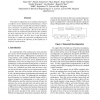Free Online Productivity Tools
i2Speak
i2Symbol
i2OCR
iTex2Img
iWeb2Print
iWeb2Shot
i2Type
iPdf2Split
iPdf2Merge
i2Bopomofo
i2Arabic
i2Style
i2Image
i2PDF
iLatex2Rtf
Sci2ools
RSP
2000
IEEE
2000
IEEE
A Hardware Virtual Machine for the Networked Reconfiguration
Networked reconfiguration is an enabling technology for cost effective service deployment and maintenance. A hardware virtual machine to enable this networked reconfigurapresented. An abstract FPGA model is the core of ardware virtual machine. Based on this abstract FPGA model, the traditional implementation flow of FPGA has been separated into two parts: the service provider's side and client's side. We show how to split the FPGA design flow to enable this networked reconfiguration and present first results in the efficiency of the bytefiles for a hardware virtual machine.
| Added | 25 Aug 2010 |
| Updated | 25 Aug 2010 |
| Type | Conference |
| Year | 2000 |
| Where | RSP |
| Authors | Yajun Ha, Patrick Schaumont, Marc Engels, Serge Vernalde, Freddy Potargent, Luc Rijnders, Hugo De Man |
Comments (0)

